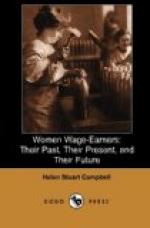[1] Dynamic Sociology, or Applied Social Science as based upon Statical Sociology and the Less Complex Sciences. By Lester F. Ward, A.M., vol. i. p. 649.
[2] Economics, book i. chap. ix.
[3] Ancient Law, p. 147.
II.
Employments for women during the
colonial period, and the development
of
the factory.
For nearly a century and a half, dating from the landing of the Pilgrims on Plymouth Rock, the condition of laboring women was that of the same class in all struggling colonies. There were practically no women wage-earners, save in domestic service, where a home and from thirty to a hundred dollars a year was accounted wealth, the latter sum being given in a few instances to the housekeepers in great houses. Each family represented a commonwealth, and its women gave every energy to the crowding duties of a daily life filled with manifold occupations.
The farmer—for all were farmers—was often blacksmith, shoemaker, and carpenter, and more or less proficient in every trade whose offices were called for in the family life. The farmer’s wife spun and wove the cloth he wore and the linen that made his household furnishing, and was dyer and dresser, brewer and baker, seamstress, milliner, and dressmaker. The quickness, adaptiveness to new conditions, and the fertility of resource which are recognized as distinguishing the American, were born of the colonial struggle, especially of the final one which separated us forever from English rule.
The wage of the few women found in labor outside the home was gauged by that which had ruled in England. For unskilled labor, as that employed occasionally in agriculture, this had been from one shilling and sixpence for ordinary field work to two shillings a week paid in haying and harvest time. For hoeing corn or rough weeding there is record of one shilling per week, and this is the usual wage for old women. To this were added various allowances which have gradually fallen into disuse. A full record of these and of rates in general will be found in “Six Centuries of Work and Wages."[4]
Unskilled labor during the whole colonial period—meaning by this such labor as that of the men who sawed wood, dug ditches, or mended roads, mixed mortar for the mason, carried boards to the carpenter, or cut hay in harvest time—brought a wage of seldom more than two shillings a day, fifteen shillings a week making a man the envy of his fellows, while six or seven was the utmost limit for women of the same order.




